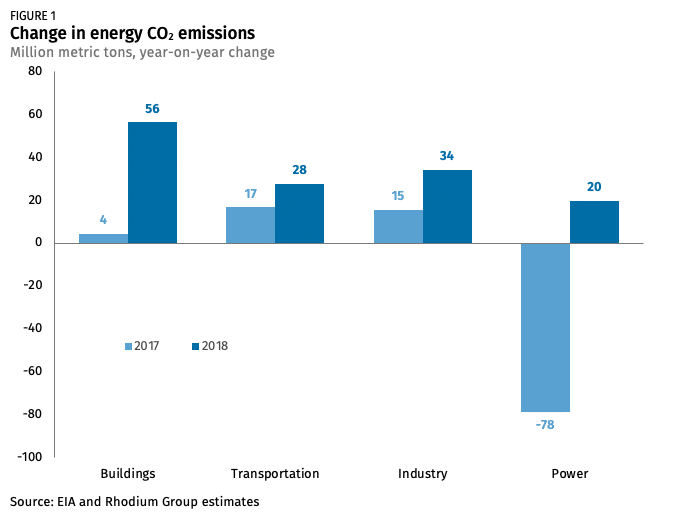Declining US greenhouse gas emissions: a Republican fairy tale
By Dawn Stover | October 25, 2019
 Mandy Gunasekara, who founded a nonprofit to tout the Trump administration’s environmental gains, spoke to environmental journalists in Fort Collins, Colorado, on October 11. Credit: SEJ
Mandy Gunasekara, who founded a nonprofit to tout the Trump administration’s environmental gains, spoke to environmental journalists in Fort Collins, Colorado, on October 11. Credit: SEJ
As a writer who has covered climate change for many years, I’m accustomed to hearing a lot of misinformation about the science. Still, I rarely hear something as brazenly false as the claim made by Republican climate strategist Mandy Gunasekara at a luncheon plenary on October 11. Speaking to hundreds of reporters attending the Society of Environmental Journalists annual conference, Gunasekara said Republicans have an environmental “success story” to tell about reducing greenhouse gas emissions.
Wait, whaaaaat? While US emissions declined slightly during Trump’s first year in office, they spiked in 2018, according to independent research.
Welcome to the Trump world of “alternative facts,” where global warming is not a problem. Because up is down.
The misinformation. Gunasekara should know better. She served as Principal Deputy Assistant Administrator for the EPA’s Office of Air and Radiation in the Trump administration and refers to herself as the “chief architect” of the strategy to withdraw from the Paris Climate Accord. She now runs the Mississippi-based “dark money” Energy 45 Fund, a nonprofit “dedicated to informing the public about the environmental and economic gains made under the Trump administration.” Or misinforming the public, in the case of her remarks at the luncheon, where she unabashedly and repeatedly claimed that US emissions are dropping, and credited Trump policies such as the Affordable Clean Energy Rule (which replaced the Obama administration’s Clean Power Plan) with the progress.
“I understand what you’re putting out there, but that is simply not true,” countered Heather McTeer Toney, the national field director of Moms Clean Air Force and a former EPA regional administrator, who was also a panelist at the plenary. “It’s information like that that gets put into the sphere of voters all over this country, and they believe rhetoric.” Toney challenged Gunasekara to provide “any scientific information” that shows US emissions are now dropping.
“Nothing I said was rhetoric or misinformation,” Gunasekara insisted. “I can send you the report from IEA [the International Energy Agency] and from EIA [the US Energy Information Administration]. Those are nonpartisan, nonpolitical entities that just monitor what’s going on in the world.”
Later in the panel discussion, when Toney and Gunasekara again disagreed on the Trump track record, Toney pointed to the crowd and said, “I’m going to assume that these are journalists, so they can go and do the research and find out for themselves.”
That’s exactly what I did.
The facts, part one. I started with the International Energy Agency, which collects and analyzes a variety of energy statistics. In a status report on the latest trends in energy-related carbon dioxide emissions from fuel combustion, the agency had this to say: “In the United States, the emissions reductions seen in 2017 were reversed, with an increase of 3.1 percent in carbon dioxide emissions in 2018.”
The uptick was partly because of weather conditions, which drove up the demand for both heating and cooling in 2018. Extreme weather events, such as heat waves, are the primary way that many people are already experiencing climate change.
I then checked the other source cited by Gunasekara. In September of last year, the US Energy Information Administration, which is part of the Energy Department, reported that carbon dioxide emissions from energy consumption fell slightly in 2017. It is now more than a year since that report, and a fresh report analyzing emissions data for 2018 is still “under review.” However, data buried in the agency’s latest monthly report (released in late September) estimate that energy-related emissions rose by 2.7 percent in 2018—three times the size of the previous year’s decline in emissions.
(It’s important to note here that the two agencies are independent of one another and use different methods and data sets to calculate emissions—which is why the figures vary, by just under half of a percentage point. But the takeaway is clear: Both agencies that Gunasekara specifically named found a distinct increase in US emissions in 2018.)
Incidentally, the International Energy Agency (IEA) also reported that the United States in 2018 “had the largest increase in oil and gas demand worldwide. Gas consumption jumped 10 percent from the previous year, the fastest increase since the beginning of IEA records in 1971.” The rise in gas consumption is offsetting reductions in coal-fired power generation that drove much of the US emissions decline in previous years.
The facts, part two. Investigating further, I checked several other reputable sources that report on emissions trends, starting with the US Environmental Protection Agency. On October 17 of last year, the EPA issued a news release bragging about a decrease in emissions during Trump’s first year in office and attributing it to Trump’s “regulatory reform agenda” and “action-oriented approach.” A year later, all I’m hearing from the EPA is crickets.
Last year’s EPA announcement claimed that “total US greenhouse gas emissions reported decreased by 2.7 percent from 2016 to 2017,” but that figure was only for power plants and other large sources of direct emissions that are part of EPA’s Greenhouse Gas Reporting Program, and the estimate was later (in a data table that few people are likely to read) downsized to a 2.3 percent decrease. The total US greenhouse gas inventory declined by only 0.5 percent that year; in other words, the announcement cherry-picked the data and relied on an uncorrected data set.
And the latest data for the Greenhouse Gas Reporting Program show that emissions increased by 2.2 percent from 2017 to 2018—a complete reversal of the trend during the previous two years.
Further evidence for rising US emissions comes from the Rhodium Group, an independent research provider, which estimates that US carbon dioxide emissions from fossil fuel combustion rose by 2.7 percent in 2018, the second-largest annual increase since 2000. Economy-wide, Rhodium estimates that greenhouse gas emissions (in other words, not just carbon dioxide emissions but also methane and other greenhouse gases—and from all sources, not just the burning of fossil fuels) rose by between 1.5 percent and 2.5 percent.

Finally, the latest BP Statistical Review of World Energy, published in June by one of the world’s largest oil and gas companies, reports that US carbon dioxide emissions from the burning of oil, gas, and coal grew by 2.6 percent in 2018. US emissions grew faster than the global average rate of 2 percent.
In other words, at least five major research entities—including two endorsed by Gunasekara herself—confirm that US emissions rose significantly in 2018. Gunasekara’s “success story” falls apart.
Informing the public. Finding the latest information about US emissions trends takes a little digging, which can be hard in an era of active disinformation about climate change—a problem made worse when responsible sources of authoritative information, such as the Energy Information Administration and the EPA, did not publish announcements to alert the media when US emissions took a giant U-turn during Trump’s second year in office. That made it easier for Gunasekara and other Trump surrogates to continue spreading their false narrative.
Gunasekara’s website proudly states: “Remarkably we have drilled our way to lower gas prices, lower unemployment, and lower emissions.”
Remarkable, indeed.
Does the woman who once served as counsel to Oklahoma Republican Senator Jim Inhofe and handed him the snowball for his infamous climate-denial speech actually believe that emissions are going down, contrary to her own sources? Has she just been too busy “informing the public” to update her information since 2017? Did she cancel her subscriptions to the Washington Post and the New York Times? Or is her emissions fairy tale a sign of things to come in the Trump 2020 campaign, which is reportedly seeking climate “victories” to tout?
When a leading Republican “climate and energy strategist and communicator” is willing to tell a flagrant falsehood to hundreds of journalists who are far better informed about climate change than the general public—and then double down when challenged—that takes climate denial to a whole new level.
It’s no wonder that climate change has, as Gunasekara said, “become a divisive and a not very pragmatic conversation.” It’s virtually impossible to have a fruitful conversation with someone who believes they are entitled not only to their own opinions, but also to their own facts.
Together, we make the world safer.
The Bulletin elevates expert voices above the noise. But as an independent nonprofit organization, our operations depend on the support of readers like you. Help us continue to deliver quality journalism that holds leaders accountable. Your support of our work at any level is important. In return, we promise our coverage will be understandable, influential, vigilant, solution-oriented, and fair-minded. Together we can make a difference.
Keywords: emissions
Topics: Climate Change, Columnists, Opinion
















As more coal fired power plants close and / or replaced by natural gas plants co2 from power generation will continue to drop and that is a good chunk of total co2 emissions i think in the 15-20% range
The switch from coal to gas was largely responsible for declining emissions in previous years. However, US emissions surged in 2018 even as coal plant retirements continued. Demand for gas increased more than 10% from 2017 to 2018, the highest increase since the early 1950s.
Please keep reporting, its not just emissions going up nationwide emissions going up, but nearly every environmental concern from clean air, clean water and clean food have significantly been degraded by government actions or inactions since republicans took over the agencies in early 2017. Look closely at the EPA and FDA for gross negligence as well…
The hijacking of federal agencies is disturbing. Thank you for not letting Mandy G get away with this kind of messaging. In her position she can spread a lot of misinformation and really do a lot of lasting damage.